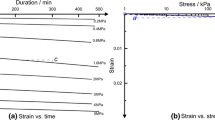The article presents the results of assessing the compressed thickness criterion for various hypotheses regarding the development of soil creep deformations. Using a simple example, it is shown that the calculations of the settlements development in time, based on the hypothesis that the creep phenomenon is observed only after the end of the filtration consolidation processes (hypothesis A), underestimate the active power of the compressed thickness of soft soils. It is concluded that it is advisable to calculate deformations in accordance with hypothesis B, when the process of creep of the soil skeleton is considered independently, regardless of the filtration consolidation process and its end time.
Similar content being viewed by others
References
V. A. Vasenin, “Compressed thickness limitation criteria in settlement analysis of buildings and structures footings. Part 1. Theoretical estimates taking into account secondary consolidation,” Geotekhnika, 12, No. 2, 22-37 (2020).
V. A. Vasenin, “Compressed thickness limitation criteria in settlement analysis of buildings and structures footings. Part 2. Realization of complex calculations applicable to St. Petersburg’s engineering- geological conditions,” Geotekhnika, 12, No. 3, 6-25 (2020).
C. C. Ladd, J. T. Germaine, R. Lancellotta, and M. B. Jamiolkowski, “New developments in field and laboratory testing of soils,” Proceedings of the 11th International Conference on Soil Mechanics and Foundation Engineering (ICSMFE), 1, 57-153 (1985).
C. C. Ladd, R. Foott, K. Ishihara, et al., “Stress deformations and strength characteristics: State-of-the art reports,” Proceedings of the 9th International Conference on Soil Mechanics and Foundation Engineering (ICSMFE), 2, 421-494 (1977).
H. Aboshi, “An experimental investigation on the similitude in the consolidation of a soft clay, including the secondary creep settlement,” Proceedings of the 8th International Conference on Soil Mechanics and Foundation Engineering (ICSMFE), 4, 88 (1973).
A. S. K. Buisman, “Results of long duration settlement tests,” Proceedings of the 1st International Conference on Soil Mechanics and Foundation Engineering (ICSMFE), 1, 103-107 (1936).
G. Mesri and Y. K. Choi, “The uniqueness of the end-of-primary (EOP) void ratio-effective stress relationship,” Proceedings of the 11th International Conference on Soil Mechanics and Foundation Engineering (ICSMFE), 2, 587-590 (1985).
P. A. Konovalov and S. G. Bezvolev, “Analysis of results of consolidation tests of saturated clayey soils,” Osn. Fundam. Mekh. Grunt., No. 3, 7-10 (2005).
L. Bjerrum, “Engineering geology of Norwegian normally-consolidated marine clays as related to settlements of buildings,” Geotechnique, 17, No. 2, 83-118 (1967).
G. A. Imai, “Unified theory of one-dimensional consolidation with creep,” Proceedings of the 12th International Conference on Soil Mechanics and Foundation Engineering (ICSMFE), 1, 57-60 (1989).
M. Kabbaj, F. Tavenas, and S. Leroueil, “In situ and laboratory stress-strain relationships,” Geotechnique, 38, No. 1, 83-100 (1988).
S. Leroueil, “The isotache approach. Where are we 50 years after its development by Professor Šuklje? (2006 Prof. Šuklje’s Memorial Lecture),” Proceedings of the 13th Danube-European Conference on Soil Mechanics and Geotechnical Engineering, 1, 55-88 (2006).
Y. Watabe, K. Udaka, Y. Nakatani, and S. Leroueil, “Long-term consolidation behavior interpreted with isotache concept for worldwide clays,” Soils Found., 52, No. 3, 449-464 (2012).
V. A. Vasenin, “Method for determining the overcompaction pressure based on the statistical dependences of the distribution of the compression index. Part 1. Substantiation of the method,” Inzh. Geol., 14, No. 3, 38-57 (2019).
G. Mesri and P. M. Godlewski, “Closure: Time- and stress-compressibility interrelationship,” Soils Found., 105, No. GT1, 106-113 (1979).
G. Mesri and A. Castro, “The Cα/Cc concept and K0 during secondary compression,” J. Geotech. Eng., 113, No. 3, 230-247 (1987).
Y. Murakami, “Excess pore-water pressure and preconsolidation effect developed in normally consolidated clays of some age,” Soils Found., 19, No. 4, 17-29 (1979).
SNIP 2.02.01-83*, Soil Bases of Buildings and Structures [in Russian], FGUP TsPP, Moscow (2006).
SP 22.13330.2016, Soil Bases of Buildings and Structures. Updated Edition of SNIP 2.02.01-83* [in Russian], Minstroi Rossii, Moscow (2006).
SP 23.13330.2018, Soil Bases of Hydraulic Structures. Updated Edition of SNIP 2.02.02-85 [in Russian], Minstroi Rossii, Moscow (2018).
Author information
Authors and Affiliations
Corresponding author
Additional information
Translated from Osnovaniya, Fundamenty i Mekhanika Gruntov, No. 4, July-August, 2021.
Rights and permissions
About this article
Cite this article
Vasenin, V.A. Analysis of the Compressed Thickness Limitation Criterion in Soft Soils for Various Models of Creep Accounting. Soil Mech Found Eng 58, 280–286 (2021). https://doi.org/10.1007/s11204-021-09740-0
Published:
Issue Date:
DOI: https://doi.org/10.1007/s11204-021-09740-0




